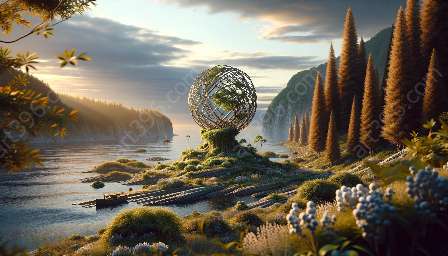Environmental sculptures, often referred to as environmental art, have a profound impact on the human psyche, evoking a wide range of emotions and responses. These sculptural installations and creations interact directly with their surroundings, utilizing various natural elements to create immersive and thought-provoking experiences for viewers. Understanding the psychological effects of experiencing environmental sculptures involves delving into the realms of sensory perception, emotion, and cognitive responses.
Interconnected with Nature
Environmental sculptures are inherently intertwined with nature, often utilizing natural materials and landscapes to create harmonious, symbiotic relationships. This connection with the natural world can trigger a sense of awe and reverence in individuals, fostering feelings of interconnectedness and environmental consciousness. When viewers engage with these sculptures, they may experience a heightened sense of appreciation for the beauty and complexity of the environment, leading to a deeper understanding of their place within the natural world.
Emotional Responses
Experiencing environmental sculptures can evoke a wide spectrum of emotional responses, ranging from tranquility and serenity to excitement and wonder. The deliberate use of form, scale, and placement within the natural environment can elicit emotional states that resonate deeply within viewers. The juxtaposition of man-made structures within untamed landscapes or the integration of sculptures with natural elements can stir feelings of harmony or dissonance, prompting contemplation and introspection.
Environmental Consciousness
Environmental sculptures often serve as poignant reminders of the delicate balance between human intervention and the natural world. By integrating art with nature, these sculptures can stimulate conversations about ecological sustainability, human impact on the environment, and the preservation of natural landscapes. Viewers may experience a heightened sense of environmental consciousness, leading to introspection and potential shifts in attitudes and behaviors towards ecological conservation.
Sensory Immersion
One of the most compelling aspects of environmental sculptures is their ability to engage the human senses on multiple levels. The tactile qualities of natural materials, the play of light and shadow on sculptural forms, and the soundscape of the surrounding environment all contribute to a multisensory experience. This immersion in sensory stimuli can evoke profound emotional and psychological responses, engaging viewers in a deeply personal and introspective encounter with the artwork.
Cognitive Engagement
Environmental sculptures often challenge traditional modes of perception and cognition by presenting viewers with novel perspectives and spatial relationships. The process of navigating these sculptural environments can prompt cognitive engagement and exploration, encouraging individuals to reframe their understanding of space, form, and their own place within the environment. This cognitive stimulation can lead to moments of insight and revelation, expanding the viewer's mental landscape.
Aesthetic Appreciation
By integrating art with the natural landscape, environmental sculptures invite viewers to engage in aesthetic contemplation and appreciation. The integration of artistic expression within natural settings prompts an exploration of beauty, form, and composition, fostering a heightened aesthetic sensibility. This aesthetic appreciation can elevate the viewer's emotional and psychological connection to the environment, deepening their experience of the sculptural installation.
Experiencing environmental sculptures is a profoundly personal and transformative journey, inviting individuals to explore their emotional, cognitive, and sensory responses within the context of the natural world. These immersive artworks serve as powerful catalysts for introspection, environmental consciousness, and emotional resonance, leaving a lasting psychological impact on those who encounter them.

